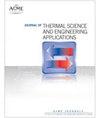MACHINE LEARNING AIDED NUMERICAL AND EXPERIMENTAL INVESTIGATION OF HYDRODYNAMIC PERFORMANCE IN THE CIRCULATING FLUIDIZED BED BOILER
IF 1.4
4区 工程技术
Q3 ENGINEERING, MECHANICAL
引用次数: 0
Abstract
This research aims to demonstrate the advantages of combining machine learning algorithms with the realm of thermo-fluidic applications. The primary objective of this investigation is to pinpoint the essential hydrodynamic input parameters that can maximize the advantages of fluidization and lead to an improved design for a CFB furnace, utilizing the Apriori algorithm. Also, this algorithm is capable of identifying the right combinations of parameters that can produce maximum fluidization performance. The end results suggested by this AA are validated using computational fluid dynamics package. For this, the transient behavior of a scaled down (1:20) reactor model of a real time industrial CFB boiler is simulated using ANSYS FLUENT 18.0. In specific, the effects of fluidizing velocities, inventory heights of the bed, and particle sizes recommended by the AA are investigated. Here, the effects are assessed in terms of volume fraction distribution and axial velocity profile distribution profiles. From the results of simulations, it was clearly found that 2 m/s inlet velocity produced good circulating fluidized bed patterns on a bed inventory height of 0.5 m for a mean particle size of 200 microns. The results obtained from the simulations are once again validated visually against snapshots obtained during real-time laboratory fluidization experimental runs. Also, it is found that the manual time taken to identify the right combinations of parameters is drastically reduced by this method as against conventional optimization algorithm and trial -error methods.循环流化床锅炉流体力学性能的机器学习辅助数值和实验研究
本研究旨在展示将机器学习算法与热流体应用领域相结合的优势。这项研究的主要目的是利用 Apriori 算法,找出能够最大限度发挥流化优势的基本流体动力输入参数,从而改进 CFB 炉的设计。此外,该算法还能确定能产生最大流化性能的正确参数组合。通过使用计算流体动力学软件包,验证了 AA 所建议的最终结果。为此,使用 ANSYS FLUENT 18.0 模拟了实时工业 CFB 锅炉按比例缩小(1:20)的反应器模型的瞬态行为。具体而言,研究了流化速度、床层高度和 AA 推荐的颗粒尺寸的影响。在此,从体积分数分布和轴向速度分布曲线的角度对这些影响进行了评估。模拟结果清楚地表明,在平均粒径为 200 微米的情况下,2 米/秒的入口速度可在 0.5 米的床层库存高度上产生良好的循环流化床模式。模拟结果与实验室实时流化实验运行时获得的快照再次进行了直观验证。此外,与传统的优化算法和试错法相比,该方法大大减少了人工确定正确参数组合所需的时间。
本文章由计算机程序翻译,如有差异,请以英文原文为准。
求助全文
约1分钟内获得全文
求助全文
来源期刊

Journal of Thermal Science and Engineering Applications
THERMODYNAMICSENGINEERING, MECHANICAL -ENGINEERING, MECHANICAL
CiteScore
3.60
自引率
9.50%
发文量
120
期刊介绍:
Applications in: Aerospace systems; Gas turbines; Biotechnology; Defense systems; Electronic and photonic equipment; Energy systems; Manufacturing; Refrigeration and air conditioning; Homeland security systems; Micro- and nanoscale devices; Petrochemical processing; Medical systems; Energy efficiency; Sustainability; Solar systems; Combustion systems
 求助内容:
求助内容: 应助结果提醒方式:
应助结果提醒方式:


